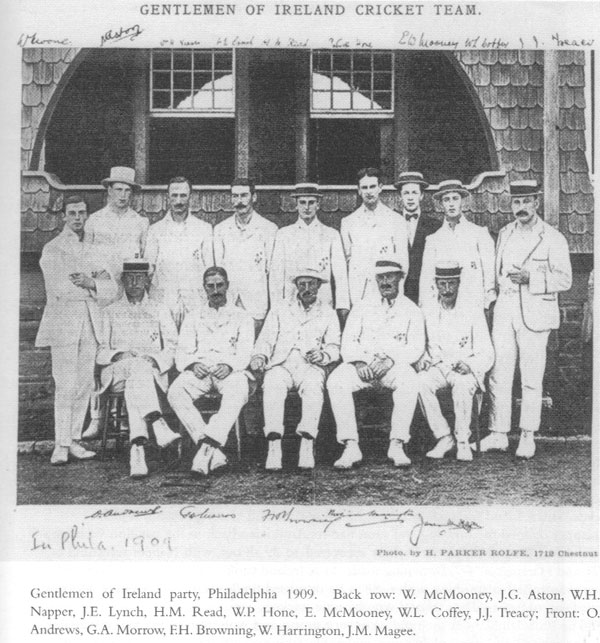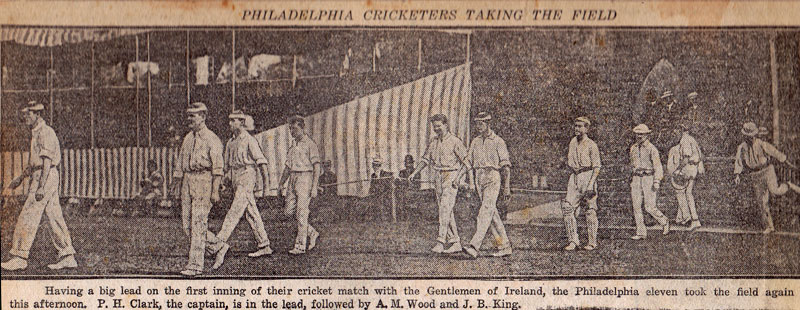In considering the 1973 tour of the USA and Canada, I decided it would be interesting to look back at the 3 tours undertaken in the late 19th century for some sort of comparison. John Elder and Chris Harte composed a contemporary account of the tour which is posted on this site and Derek Scott wrote his own account which can be looked up in the archives. I will add some of my own recollections later.
There was a similarity in that the opposition varied wildly. In one game on the 1909 tour a New York team were 0 for 6 in their first innings but in Philadelphia Ireland were beaten twice by an innings. In fact Ireland only twice got the better of the Gentlemen of Philadelphia in eleven games between 1879 and 1909.
 Ireland v Philadelphia 1888
Ireland v Philadelphia 1888
Cricket in Philadelphia in that period was thought to be of English county standard. In 1893 they defeated the Australians en route home from England. The game was very much the preserve of the well to do and there was enough wealth and gate receipts for a club like Germantown to sponsor an entire Irish tour. In more recent times Philadelphia occasionally hold cricket festivals but the posh clubs are now general sports clubs with a wide range of activities.
After the Great War cricket virtually disappeared in the area. When the Irish tour in 1973 was organised there appears to have been no thought of going there and we played in Louisville, Chicago, Toronto, Palo Alto near San Francisco and Los Angeles. Toronto was also the Canadian venue for the Irish sides in the 19th century and in 1909. We only came across a couple of native American cricketers whereas in the Philadelphia of 1909 their team had a large majority of local Americans.
Sports historians have researched and concluded that in 1830s and 40s USA cricket and baseball both flourished with many playing both games. Despite what many Americans wish to believe, baseball was imported from England along with cricket in the 18th century, along with other variations of stick and ball games.
It is also the belief of historians that baseball became the favoured game in the 19th century because of the slow nature of cricket and matches that could last 3 days. It is said that baseball suited the American psyche better. It is interesting to surmise that if 20/20 cricket had existed in the mid 19th century would it have become the preferred game. If you are interested try Right off the Bat: Baseball, Cricket, Literature and Life by Martin Rowe (a cricketer) and Evander Lomke (baseball player).
Back in 1879 the first Irish tour landed in New York. It was composed entirely of members of Phoenix. This is not entirely surprising as Phoenix was a sort of Irish equivalent of the MCC with its members drawn from many clubs. 19th century Irish cricketers could have been members and players in several clubs. They played 13 matches in the US and Canada, winning 10, drawing 2 and losing 1 to Philadelphia, in front of 5000 spectators. A pro, Rylott of Leicestershire, was brought, but only as an umpire. After complaints in New York from the home team about his umpiring the next game v Young America was cancelled.
It was claimed that 'in a match among gentlemen, gentlemen must umpire'.
In 1892 the Gentlemen sent a strong team, despite the absence of key players such as Lucius Gwynn, Frank Browning and Sir TC O'Brien. They won one game against Philadelphia, drew one and lost one. Because of a dispute between Dublin clubs, it is likely that the captain, JM Meldon picked the side himself.
 Ireland v Philadelphia 1892
Ireland v Philadelphia 1892
Starring on the Irish side was Bud Hamilton, a slow left arm bowler and attacking batsman, compared by his captain to Gilbert Jessop. He was capped for Ireland in hockey, badminton and tennis as well. When in Toronto he broke the Canadian all comers record in the pole vault!
It was on this tour that the Irish players first came across John Barton King, then 18. He was a fast bowler who had played baseball and had used his knowledge of the baseball swerve to develop a lethal late inswinger. He could also bowl away swingers and a fast straight yorker. He is seen by many as one of the best bowlers ever, anywhere.
Bart King obviously didn't play test cricket and had only occasional exposure to English county cricketers, but on tour in 1908 he took 87 first class wickets and headed the English averages at 11.01. On that tour the Philadelphians played Ireland in College Park. He took 7 for 40 in the first innings and 7 for 23 in the second in a convincing innings victory. He caused the match to be over so quickly that a second match was played which was drawn. He took pity on the Irish by playing solely as a batsman!
In 6 games against The Gentlemen, beginning in 1892, his statistics are 255 overs/95 maidens/471 runs/58 wickets average 8.1. He was also a famous joker, indulging in early versions of sledging. In one local match in Philadelphia he took exception to the opposition captain who he thought had been a bit arrogant by turning up late. He sent all his fielders to the pavilion, then brought one back to stand about 30 yards from the stumps at fine leg. The batsman enquired why he had one fielder and in that position. 'To pick up the bails' was King's answer. Sure enough he was bowled first ball and the bails were retrieved at the feet of fine leg. On the Irish tour of 1909, which was the last until 1973, when Philadelphia defeated the Gentlemen twice by an innings, King took all 10 wickets in the first innings of the first match and a hattrick in the second innings.
 Ireland v Philadelphia 1909
Ireland v Philadelphia 1909
1909 was close to the end of a 'golden age' for Irish cricket and these American tours understandably saw weakened selections travel but by all accounts they were memorable adventures and they were royally entertained everywhere, being given honorary membership of all the clubs they played in for the duration of their stay and staying in hotels such as the Waldorf Astoria. However, there were transport problems. The 1892 party took 11 days to cross the Atlantic in continuous storms. It took days to recover and they had to play in that period. They also missed a serious train crash by deciding to stay an extra day in Boston, 'to see the sights'.

The comparison with 1973 is interesting. Travel was easy, except for a flight from Toronto which circled Chicago for 3 days waiting in a long queue, in a storm, when apparently there was only one runway operating. We missed our connection to San Francisco. However when we boarded the next available flight those of us who boarded at the end of the queue were given seats in first class while luminaries such as Jimmy Boucher and Alec O'Riordan, the skipper, sat cramped in the cheap seats. Our small group landed in San Francisco very well fed and extremely happy and loud.
Like the players in the early tours we played some games against sides that were a good bit weaker and sometimes at odd venues. Louisville was very pleasant but the cricket was a bit contrived. In Chicago we played in Washington Park which was a huge open space in a pretty run down area. Doubtful characters sometimes meandered across the outfield while police cars crawled around the boundary. The match did not start on time because the Chicago team had to spend a long time nailing down some coconut matting to play on. One night, in a reception in one of the player's apartments, I was looking out at a fine view of Chicago and I asked our host to point out the 'bad' areas. 'Man', he said, 'It's all bad'.
The Northern Californian XI we played at a fine location in Palo Alto, near the Stanford University ball park. It was captained by Alfie Cooper, who had played for Trinity, North and Ireland in 1954, before emigrating. He had captained the USA a number of times, especially in their derby match v Canada. (This is the oldest international cricket fixture) The strongest side we faced was the USA XI we played in Los Angeles at the C Aubrey Smith Field. C Aubrey Smith had been an English actor and film director who spent much of his life in show business in Hollywood. He started the cricket club named after him. It was a good ground and, I think, the only grass wicket we played on. My memory is that we were in a position to win on the last day but collapsed. I was batting with Ossie Colhoun with nine wickets down. I played out the last over of the 20 in the last hour and set off for the pav. There was time for one more, unfortunately, and Ossie was out caught behind next ball.
 USA v Ireland 1973 at C Aubrey Smith Field in Los Angeles
USA v Ireland 1973 at C Aubrey Smith Field in Los Angeles
On looking back, I feel that there was not nearly enough time for sight- seeing. One day in Toronto and one in San Francisco, when a group of us went to Sausilito by ferry. We spent the three weeks either travelling or playing with just two days free. The Irish teams of the previous tours also played regular matches but they stayed for a longer period and of course had to sail. Those teams all missed key players who could not travel. I think the only Irish player who was an automatic choice who did not travel was Dermot Monteith, and he was missed, both on and off the field.
The results in the two cap matches, against Canada and the USA were disappointing. I have mentioned the end of the game in Los Angeles. In Toronto we did not enforce the follow on and then failed to bowl them out on the last day. The wicket did not deteriorate as it was on a mat. Ivan Anderson was denied a double century when his partner was the last man out when he had made 198. It was the highest ever score in an Irish match at that time. To finish on an unfortunate note, Pat Dineen contracted gout on the plane journey and spent much of the next few days in a wheel chair. He played a one day match in LA before the 3 day match and that was his tour. Not a happy man.
I wrote this piece as a sort of introduction to John Elder and Chris Harte's account of the tour and thought that including some observations on the earlier American tours might be of interest. The Bart King story is amazing. The contrast with the modern Irish professional life as a cricketer could not be wider. The enjoyment we had playing Irish cricket in the 70s was enormous.
